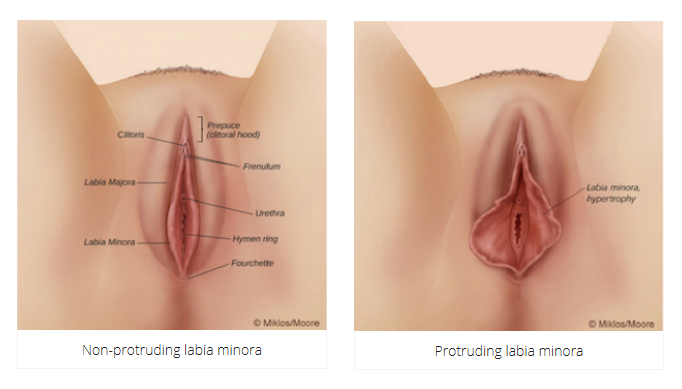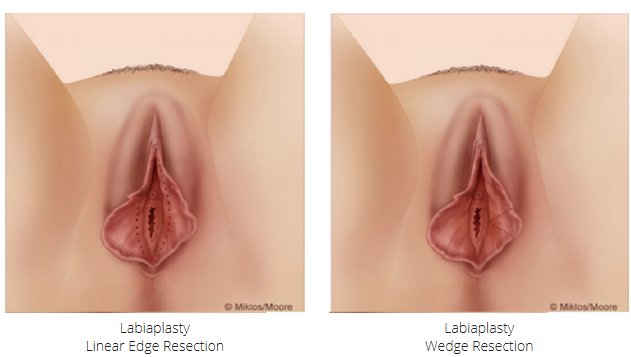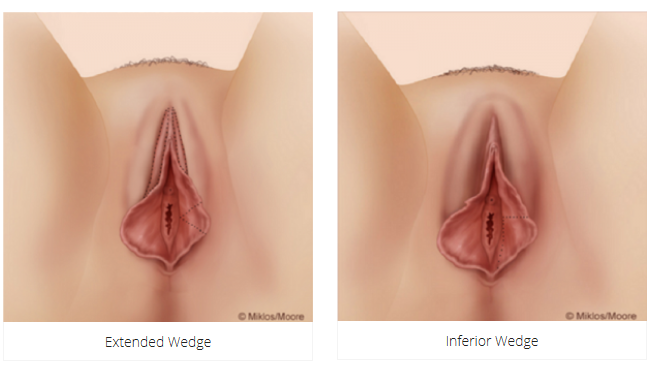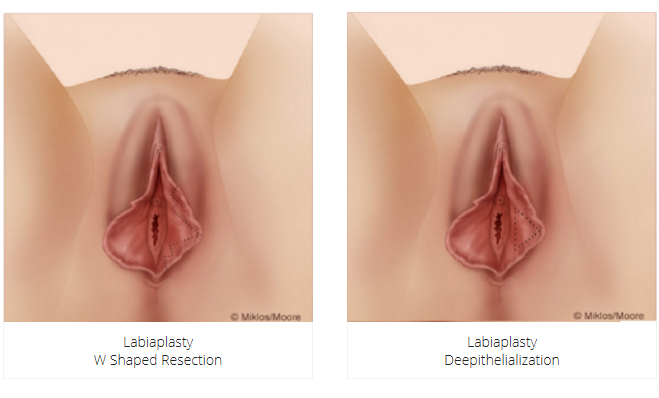Labiaplasty
| Labiaplasty defined: plastic surgery performed to alter the size and/or shape of either the inner thinner non-hair bearing labia minora or the outer wider hair bearing labia majora. (see normal anatomy figure below)Although no one really understands the cause of labia minora enlargement (i.e. labia hypertrophy), several theories have been suggested such as: hormonal reaction, genetics, excessive masturbation, multiple pregnancies, a manifestation of long-term bouts of swelling (during pregnancy), or a simple variation of normal. Labia minora hypertrophy may be a result of a single reason or a combination of one or more of the above. Patients often describe their labia minora enlargement occurring since the time of puberty (suggesting a hormonal reaction) or after pregnancy and delivery suggesting both hormonal reaction, prolonged swelling or an edema problem or a stretching effect of the delivery. Labiaplasty is usually performed for aesthetic and / or functional reasons.1 In other words, a patient will consider labiaplasty if she does not like the appearance or if the labia create irritation, discomfort, or pain often associated with wearing tight clothing, jeans or undergarments; with activities such as cycling, spinning, horseback riding or exercise and even with intercourse (sex). Labia Minora Reduction: The primary reason why women would like their labia minora reduced is because the labia minora protrude beyond the edge of the labia majora. This protrusion often causes both aesthetic and functional dysfunction (as discussed above).
There are many different techniques utilized by cosmetic vaginal surgeons to perform a labia minora labiaplasty. These techniques included but are not limited to the following: edge resection, linear or curvilinear resection, wedge resection, extended wedge resection, inferior wedge resection, posterior wedge resection, and deepithelization. The edge resection also known as a linear or curvilinear resection was the first described technique in the scientific literature. This technique remains one of the most popular techniques and patient satisfaction has been reported to be high. However, the author warns the reader that the results of any labiaplasty are only as good as the surgeon performing the surgical procedure. This technique if performed properly can reduced the protruding labia minora as well as remove the darkened skin edges in most patients. According to Miklos & Moore in a study of 550 women seeking labiaplasty surgery 99% of Caucasians, Occidentals, Hispanics preferred a lighter or pinker skin edge while only 60% of African descendants preferred a lighter skin edge. The wedge resection technique was popularized in 1998 by a plastic surgeon (Alters 1998)4 and he suggested the main indication for the wedge technique was labia protruding > 2 cm beyond the majora. A V – shaped wedge is resected out of the most protuberant part of the labia and the free edges are sutured together leaving the darkened skin edges without an obvious incision line / or scar.
A modified version of the wedge technique was published in 2008 and this labiaplasty surgery incorporates the wedge technique but extends the incision superficially to incorporate the lateral redundant prepuce.5 This is technique has been named the extended wedge technique. The inferior wedge technique was introduced and is similar to the V-wedge technique but instead of making the incision at the most protuberant portion of the labia minora, the wedge is taking out of the lower or inferior portion of the labia.
The W – shaped resection was introduced in 2000 and is described as a W-shaped resection which is repaired by interdigitating sutures of the protruding labia minora.6 Also introduced in 2000, by Choi and Kim7, was the de epithelialization technique. This technique does not cut and remove the deeper tissue of the labia but instead only removes the skin and the freshly cut free edges are repaired using sutures.
|




